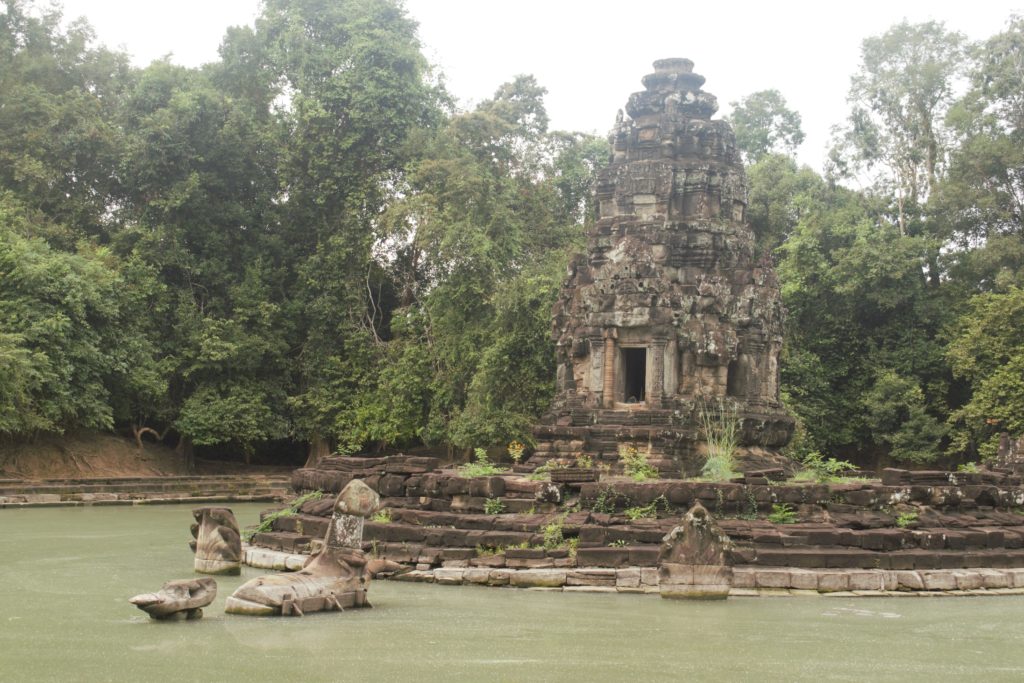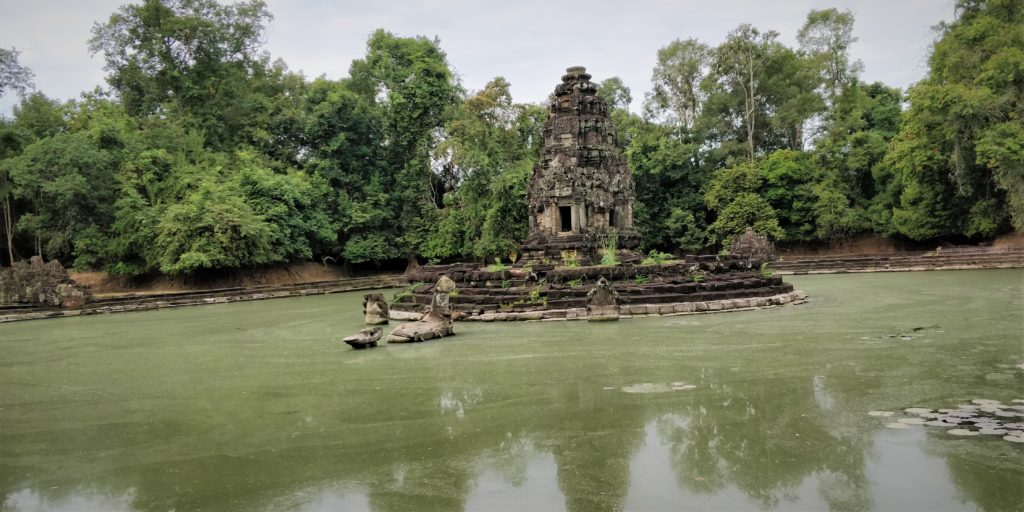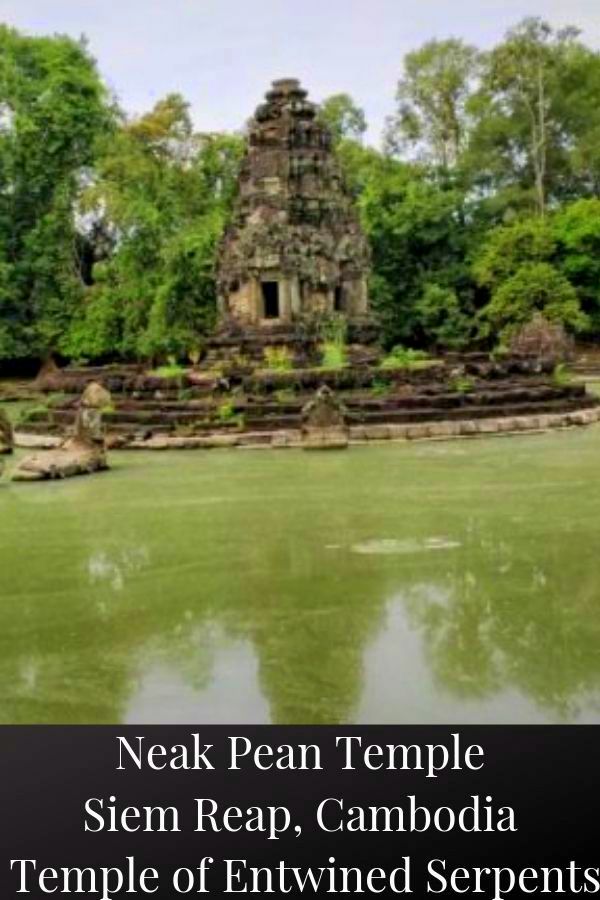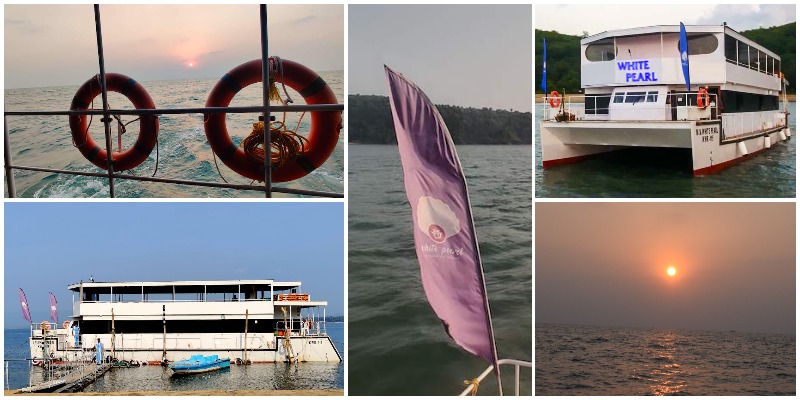Table of Contents
Neak Pean Temple, Siem Reap, Cambodia
Some places silently steal your heart. No hype, no grandeur, just enchanting simplicity and an indescribable aura that borders on the divine. One such place that enthralled us with its serene beauty was Prasat Neak Pean. Not very far from the massive Preah Khan temple, one of the largest temples in the Angkor Archaeological Park is located the enigmatic Neak Pean Temple which in many ways is a temple drastically different from what one expects of temples. Neak Pean in Khmer means entwined serpents. Our two day Siem Reap itinerary started with a visit to Neak Pean Siem Reap. The beautiful temple set the correct tone for our exploration of the enigmatic temples of Siem Reap. This was the first temple in Siem Reap for us and having been mesmerized by the temples in the vicinity of Phnom Penh like Phnom Chisor and Ta Prohm, and Phnom Da. Our visit to the National Museum at Phnom Penh which has many of the treasures found in the Siem Reap area also whetted our appetite for experiencing the beauty and majesty of the temples including that of the majestic Angkor Wat.
Neak Pean – First Impressions
We drove into the Angkor Archaeological Park after a quick breakfast at the Kingdom Angkor Hotel, where we were staying. Our first port of call in the fascinating journey that awaited us was the Neak Pean temple. Our car dropped us off by the side of the road. ‘Prasat Neak Pean’, said an innocuous-looking board in Khmer and English with an arrow pointing to the left side of the road.

As we followed the direction of the board, we were stunned by the beauty that stretched out in front of us. The tree cover on the road had ensured that we were surprised by the sheer beauty of the place.

A narrow wooden walking bridge stretched in front of us and disappeared in the lush greenery of a small island that we could just make out in the distance.

On either side of the wooden bridge, blooming pink lotuses floated in the emerald-colored waters of the Jayatataka Baray, an artificial reservoir of water that is said to have been built by King Jayavarman VII. As we walked towards the island in the center of the Baray, the soft Khmer music being played by a group of Landmine survivors soothed our minds. A cool breeze blew across the waters, the roots of dead trees floating painted a surreal picture as we walked towards the Neak Pean temple to explore the mysteries that it clutched to its bosom for centuries.
History & Myths of The Temple of Entwined Serpents

The Neak Pean temple is believed to have been completed in the mid of the 12th century. The credit for its construction goes to King Jayavarman VII. He had this built in the middle of the Jayataka Baray, a reservoir that he had got made to supply water to the residents of the nearby Preah Khan temple complex which is said to have accommodated more than 10,000 people.
It is believed that the temple was actually designed as a ‘hospital’, some sort of a wellness spa. It consisted of a central pond which was filled by the waters of four ponds in the cardinal directions through stone conduits. These four conduits had symbolic images of four animals namely, Horse, Lion, Bull, and Elephant. The central pond is said to represent the mythical lake Anvatapta. A lake that is part of Hindu mythology and it is believed that Manasarovar is its personification. The waters of this mythical lake were supposed to cure ailments. The Buddhist belief extends to considering the mythical lake as the purifier and cleanser of sins present and past.
The Neak Pean was constructed based on the Hindu premise of the balance of the elements. The four pools symbolized Water, Earth, Fire, and Wind flowing into the central pond to achieve a state of perfect balance. It is believed that people flocked to Neak Pean to bathe and pray at the central temple which was dedicated to Avalokitesvara. Of course, the presence of Avalokitesvara is ubiquitous in the Angkor Archaeological Park and beyond with his most prominent manifestation being in the enigmatic temple of Bayon.

The earliest mention of the Prasat Neak Pean is found in the accounts of Zhou Daguan, a Chinese diplomat who visited Angkor during the reign of Indravarman III. Zhou Daguan stayed in Angkor for almost eleven months between 1296 and 1297. He later wrote a book called, “Customs of Cambodia”, which was a detailed description of the temples of Angkor as well as the people of those times.
The Temple As It Stands Today

Much of the glory of the Neak Pean has been ravaged by nature and the passage of time. Most of its sculptures and reliefs have gone, except for a few remnants that have braved the effects of nature and time. However, the place still retains glimpses of its past.

One can see a central pond and in the middle of it an island with a tower-like structure. This was the temple to Avalokiteswara. The structure resembles a lotus if you stretch your imagination a bit. Two coiled serpents can be seen entwined at the base. The only surviving statue of Neak Pean can be seen in the water. This is the statue of Balaha. One can easily make out the horse-like shape of what remains of the statue. Balaha is looked up to as the King of horses in Buddhism and is considered as a form of Avalokiteswara.
Only one of the four stone conduits can be seen, it is presumed that the others were closed at some point of history.
Structurally Neak Pean consists of the main pond with the sanctum sanctorum at the center, the statue of Balaha on what would have been a footbridge connecting to the sanctum sanctorum, and the four ponds at the cardinal directions.
Looking at the greenish and silent waters of the ponds, one cannot help but think how this place must have been in its heyday, with people flocking to bathe in the ponds and rejuvenate their body, minds, and souls with the miraculous waters.
Watch our Neak Pean Video here:
Tips For Visiting Neak Pean
♠ The Angkor Pass is required for visiting Neak Pean.
♠ For details of Angkor Pass and prices check out the official site of Apsara Authority.
♠ There is really not much to see in this temple and hence about 30-40 minutes should be sufficient.
♠ Do not miss the statue of Balaha in the waters of the central pond.
♠ We recommend that you start your exploration of the Angkor temples with Neak Pean, it sets the tone for the exploration of the grander and massive temples later.
We hope you liked reading our Neak Pean travel blog post and it has been able to answer the questions that you may have had. Please do feel free to revert back to us through the comments section or any of our social media channels.
You might be interested in reading our other posts on Cambodia:
Things to do in Phnom Penh, Cambodia
2 days in Siem Reap – Itinerary for Angkor Wat & Other Temples
National Museum in Phnom Penh, Cambodia
A Guide to Vegetarian Food in Cambodia
Phnom Da, Takeo Province, Cambodia
Takeo Province, Cambodia – Phnom Chisor and Ta Prohm
Bayon Temple in Cambodia – Smile of Angkor
We were hosted by Cambodia Tourism. However, the views and opinions expressed here are our own.
Thanks for visiting our site Voyager – imvoyager.com and taking the time to read this post!
If you wish to collaborate/work with us then reach us at imvoyager18@gmail.com
Do You Love Traveling?
Do you want to know how to travel the world? We have put together a very useful travel resources page with best travel tips. Go check it out now.
Follow our journey on our social media channels:
Facebook Twitter Instagram Pinterest G+ YouTube
Thanks for visiting our site Voyager – imvoyager.com and taking the time to read this post!
If you wish to collaborate/work with us then reach us at imvoyager18@gmail.com











I can’t believe that the Neak Pean temple is still somewhat standing! Just goes to show you how well they built things back in the day. What a fascinating place to explore and not usually one you hear about when reading about the area. I love the bridge you crossed to get there, such beautiful surroundings.
Interesting that the Neak Pean Temple may have been originally designed as a hospital. There is so much symbolization in the temple. I’m sure it was interesting to look at the temple in present day and reflect on what it was like years ago.
I have heard about this temple before but I didn’t know it was originally designed as a hospital. There are so many temples around that it’s easy to miss a spectacular one like this one. If I ever get back to Siem Reap, the Neak Pean temple is on the top of my list!
What a fascinating place! An ancient wellness spa turned into temple, how interesting! Also, well done with the video, it really takes you there 🙂
I have never been to Cambodia, but I definitely have an eye on Temple Siem Reap since a long time. What a great idea that you share the map so that first-time visitors immediately known where to go first. The templs also seems to be the perfect spot to do photography.
It is interesting to know that Hindu has Water, Earth, Fire, and Wind as balanced elements. In Chinese five elements are used for balancing the Fengshui, earth, fire, water, wood and metal. Nice article and thanks for sharing.
I have never heard or read about Neak Pean Temple. I am so glad that you guys have explored this offbeat place, something that is not Angkor Wat or Bayon. It is really interesting to know about it. Thanks for the share.
It has not many years since I visited Cambodia but it already feesl like ages. I did visit Neak Pean temple and I quite liked it. Not very often you see an ancient wellness spa turned into a temple. Incredible indeed!
Neak Pean looks very serene, and it’s always interesting to understand the symbolic meanings of a place. On the surface, it appears almost underwhelming. But after understanding the story behind the Temple of Entwined Serpents, it’s really fascinating! I’m so glad you shared such important insights about this ancient spa.